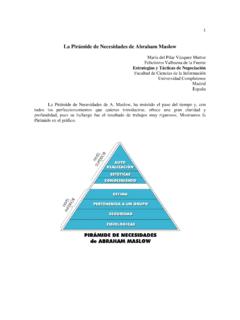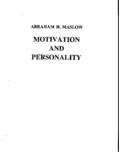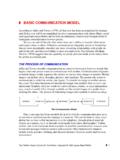Transcription of CT2 Paper 1 – Maslow Hierarchy of Needs
1 HCC Certificate in Counselling Skills Page 1 HIGHGATE COUNSELLING CENTRE CT2 Paper 1 Maslow Hierarchy of Needs Source: McLeod, S. A. (2007). Maslow 's Hierarchy of Needs Accessed December 2013 HCC Certificate in Counselling Skills Page 2 Maslow 's Hierarchy of Needs by Saul McLeod - published 2007, updated 2013 Maslow wanted to understand what motivates people. He believed that individuals possess a set of motivation systems unrelated to rewards or unconscious desires. Maslow (1943) stated that people are motivated to achieve certain Needs . When one need is fulfilled a person seeks to fulifil the next one, and so on. The earliest and most widespread version of Maslow 's (1943, 1954) Hierarchy of Needs includes five motivational Needs , often depicted as hierachical levels within a pyramid. This five stage model can be divided into basic (or deficiency) Needs ( physiological, safety, love, and esteem) and growth Needs (self-actualization).
2 The deficiency, or basic Needs are said to motivate people when they are unmet. Also, the need to fulfil such Needs will become stronger the longer the duration they are denied. For example, the longer a person goes without food the more hungry they will become. One must satisfy lower level basic Needs before progressing on to meet higher level growth Needs . Once these Needs have been reasonably satisfied, one may be able to reach the highest level called self-actualization. Every person is capable and has the desire to move up the Hierarchy toward a level of self-actualization. Unfortunately, progress is often disrupted by failure to meet lower level Needs . Life experiences including divorce and loss of job may cause an individual to fluctuate between levels of he Hierarchy . Maslow noted only one in a hundred people become fully self-actualized because our society rewards motivation primarily based on esteem, love and other social Needs .
3 HCC Certificate in Counselling Skills Page 3 The original Hierarchy of Needs five-stage model includes: 1. Biological and Physiological Needs - air, food, drink, shelter, warmth, sex, sleep. 2. Safety Needs - protection from elements, security, order, law, limits, stability, freedom from fear. 3. Social Needs - belongingness, affection and love, - from work group, family, friends, romantic relationships. 4. Esteem Needs - achievement, mastery, independence, status, dominance, prestige, self-respect, respect from others. 5. Self-Actualization Needs - realizing personal potential, self-fulfillment, seeking personal growth and peak experiences. Maslow posited that human Needs are arranged in a Hierarchy : 'It is quite true that man lives by bread alone when there is no bread. But what happens to man s desires when there is plenty of bread and when his belly is chronically filled?
4 At once other (and higher ) Needs emerge and these, rather than physiological hungers, dominate the organism. And when these in turn are satisfied, again new (and still higher ) HCC Certificate in Counselling Skills Page 4 Needs emerge and so on. This is what we mean by saying that the basic human Needs are organized into a Hierarchy of relative prepotency'. ( Maslow , 1943, p. 375) The expanded Hierarchy of Needs : It is important to note that Maslow 's (1943, 1954) five stage model has been expanded to include cognitive and aesthetic Needs ( Maslow , 1970a) and later transcendence Needs ( Maslow , 1970b). Changes to the original five-stage model are highlighted and include a seven-stage model and a eight-stage model, both developed during the 1960's and 1970s. 1. Biological and Physiological Needs - air, food, drink, shelter, warmth, sex, sleep, etc. 2. Safety Needs - protection from elements, security, order, law, limits, stability, etc.
5 3. Social Needs - Belongingness and Love, - work group, family, affection, relationships, etc. 4. Esteem Needs - self-esteem, achievement, mastery, independence, status, dominance, prestige, managerial responsibility, etc. 5. Cognitive Needs - knowledge, meaning, etc. 6. Aesthetic Needs - appreciation and search for beauty, balance, form, etc. 7. Self-Actualization Needs - realizing personal potential, self-fulfillment, seeking personal growth and peak experiences. 8. Transcendence Needs - helping others to achieve self actualization. Self Actualization Instead of focusing on psychopathology and what goes wrong with people, Maslow (1943) formulated a more positive account of human behaviour which focused on what goes right. He was interested in human potential, and how we fulfill that potential. Psychologist Abraham Maslow (1943, 1954) stated that human motivation is based on people seeking fulfillment and change through personal growth.
6 Self-actualized people as those who were fulfilled and doing all they were capable of. The growth of self-actualization ( Maslow , 1962) refers to the need for personal growth that is present throughout a person s life. For Maslow , a person is always becoming and never remains static in these terms. In self-actualization a person comes to find a meaning to life that is important to them. As each person is unique the motivation for self-actualization leads people in different directions (Kenrick et al., 2010). For some people self-actualization can be achieved through creating works of art or literature, for others through sport, in the classroom, or within a corporate setting. HCC Certificate in Counselling Skills Page 5 It is important to note that self-actualization is a continual process of becoming rather than a perfect state one reaches of a 'happy ever after' (Hoffman, 1988).
7 Maslow offers the following description of self- actualization: 'It refers to the person s desire for self-fulfillment, namely, to the tendency for him to become actualized in what he is potentially. The specific form that these Needs will take will of course vary greatly from person to person. In one individual it may take the form of the desire to be an ideal mother, in another it may be expressed athletically, and in still another it may be expressed in painting pictures or in inventions'. ( Maslow , 1943, pp. 382 383). Maslow (1968): Some of the characteristics of self-actualized people Although we are all, theoretically, capable of self-actualizing, most of us will not do so, or only to a limited degree. Maslow (1970) estimated that only two percent of people will reach the state of self actualization. He was particularly interested in the characteristics of people whom he considered to have achieved their potential as persons.
8 By studying 18 people he considered to be self-actualized (including Abraham Lincoln and Albert Einstein) Maslow (1970) identified 15 characteristics of a self-actualized person. Characteristics of self-actualizers: 1. They perceive reality efficiently and can tolerate uncertainty; 2. Accept themselves and others for what they are; 3. Spontaneous in thought and action; 4. Problem-centered (not self-centered); 5. Unusual sense of humor; 6. Able to look at life objectively; 7. Highly creative; 8. Resistant to enculturation, but not purposely unconventional; 9. Concerned for the welfare of humanity; 10. Capable of deep appreciation of basic life-experience; 11. Establish deep satisfying interpersonal relationships with a few people; 12. Peak experiences; HCC Certificate in Counselling Skills Page 6 13. Need for privacy; 14. Democratic attitudes; 15. Strong moral/ethical standards.
9 Behavior leading to self-actualization: (a) Experiencing life like a child, with full absorption and concentration; (b) Trying new things instead of sticking to safe paths; (c) Listening to your own feelings in evaluating experiences instead of the voice of tradition, authority or the majority; (d) Avoiding pretense ('game playing') and being honest; (e) Being prepared to be unpopular if your views do not coincide with those of the majority; (f) Taking responsibility and working hard; (g) Trying to identify your defenses and having the courage to give them up. The characteristics of self-actualizers and the behaviors leading to self-actualization are shown in the list above. Although people achieve self-actualization in their own unique way, they tend to share certain characteristics. However, self-actualization is a matter of degree, 'There are no perfect human beings' ( Maslow , 1970a, p.)
10 176). It is not necessary to display all 15 characteristics to become self-actualized, and not only self-actualized people will display them. Maslow did not equate self-actualization with perfection. Self-actualization merely involves achieving ones potential. Thus someone can be silly, wasteful, vain and impolite, and still self-actualize. Less than two percent of the population achieve self-actualization. Critical Evaluation The most significant limitation of Maslow 's theory concerns his methodology. Maslow formulated the characteristics of self-actualized individuals from undertaking a qualitative method called biographical analysis. He looked at the biographies and writings of 18 people he identified as being self-actualized. From these sources he developed a list of qualities that seemed characteristic of this specific group of people, as opposed to humanity in general.






